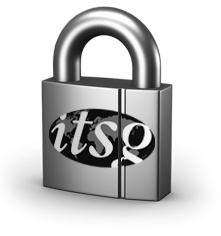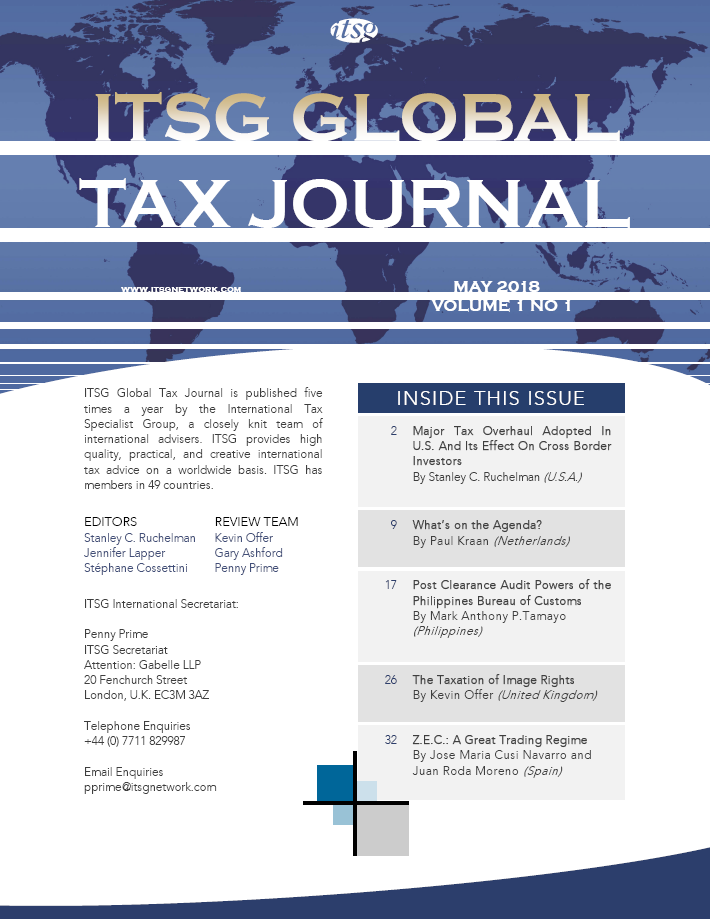Introduction
Dating back to the enactment of Subpart F of U.S. tax law in 1962, the United States has been a leader in the development of tax policy affecting international transactions. While some believe that the United States lost its leadership position during the development of B.E.P.S., the enactment of the Tax Cuts & Jobs Act ("T.C.J.A.") in late December 2017 should dispel that view. Among other things,
- Corporate tax rates were cut to 21%,
- The scope of controlled foreign corporation rules was expanded,
- A dividends received deduction ("D.R.D.") was adopted for intercompany dividends received from 10%-owned foreign subsidiaries,
- Deductions were given for the use of foreign derived intangible income generated by U.S. businesses from operations in the U.S.,
- Taxation was accelerated for the earnings of controlled foreign corporations deriving profits through the use of intangible property abroad.
These and other changes in U.S. tax policy are discussed in this article.
Broadened Scope of Subpart F
Subpart F is applicable to C.F.C.’s and their U.S. Shareholders, as defined below. It is the principal anti-deferral regime of relevance to a U.S.-based multinational corporate group. Under Subpart F, U.S. Shareholders of a C.F.C. are taxed on their pro rata shares of certain C.F.C. income (referred to as Subpart F income) automatically even if no dividend is received from the C.F.C. Within certain limitations, dividends that are paid subsequently by a C.F.C. are deemed to come from previously taxed earnings of the C.F.C. and are not taxed when received.
A C.F.C. generally is defined as any foreign corporation in which "U.S. Shareholders" own (directly, indirectly, or constructively) shares representing more than 50% of the corporation’s voting power or value. Certain rules of attribution are applied to treat shares owned by one person as if owned by another. Shares can be attributed between individuals, corporations, partnerships, trusts and estates. Consequently, shares owned in one company can be attributed from a shareholder to another company owned by that shareholder for the purposes of determining, inter alia, whether the other company is a U.S. Shareholder of a C.F.C. and whether two companies are related because one controls the other or both are under common control. Although ownership of shares is attributed from one person to another for the foregoing purposes, that attribution does not cause the ultimate U.S. Shareholder to be taxed under Subpart F on the income of the C.F.C. In other words, income follows legal ownership, notwithstanding ownership by attribution.
Under prior law, a "U.S. Shareholder" was a U.S. person that owned shares of the foreign corporation having 10% of the voting power. For this purpose, U.S. persons included U.S. citizens, U.S. residents, U.S. corporations, U.S. domestic trusts or estates, and U.S. partnerships and L.L.C.’s. In applying the attribution rules, shares could not be attributed from a foreign corporation that is a shareholder of a U.S. corporation to that U.S. corporation, a rule often used to decontrol a C.F.C. In addition, before Subpart F could apply to a C.F.C. and its U.S. Shareholders, a foreign corporation was required to be a C.F.C. for at least 30 days during the taxable year.
The T.C.J.A. made several changes to the provisions of Subpart F. First, the definition of a U.S. Shareholder was expanded so that a person that does not own 10% of the voting shares can be considered to be a U.S Shareholder if shares representing 10% of the value of the foreign corporation are owned. As long as one test is met, the U.S. person is considered to be a U.S. Shareholder.
Second, shares in a foreign affiliate that are owned by a foreign parent can be attributed to a U.S. subsidiary of the foreign corporation. As a result, foreign based groups with members in many countries, including the U.S., may find that all members based outside the U.S. are at risk of becoming controlled foreign corporations for certain U.S. tax purposes with the U.S. affiliate treated as if it were the parent company of the group. This can broaden the scope of information reporting, but not the imposition of tax. Earlier this year, the I.R.S. announced that it is reviewing the scope of the provision with a goal of limiting its application.
Finally, a foreign corporation is no longer required to be a C.F.C. for at least 30 days in order for Subpart F to apply to its U.S. Shareholders. This provision affects many tax plans put in place for high net worth individuals having children who live in the U.S. Those plans typically involved the use of foreign blocker corporations that protected U.S. situs investment assets from the imposition of U.S. estate taxes for a non-U.S. parent. At the same time, the plans allowed the children to have a tax-free step-up in the cost basis for underlying investment assets if the foreign blocker were liquidated promptly after the parent's death.
Cross-border intercompany dividends received deduction
Generally, U.S. citizens, residents and domestic corporations are considered to be U.S. persons subject to tax on worldwide income. To eliminate double taxation of income, the U.S. allows a credit against Federal income tax for foreign income taxes paid on foreign source income. For taxpayers that are corporations, an indirect credit was allowed under prior law for foreign income taxes paid by foreign corporations when the U.S. corporation owned shares in a foreign corporation representing 10% or more of the voting power of the first-tier subsidiary and several lower levels in a chain of ownership. The pool of taxes associated with post 1986 earnings were deemed paid on a proportional basis as the earnings in that pool were distributed. The indirect foreign tax credit reached down to the 6th level of foreign subsidiary, so long as the U.S. corporation indirectly owned at least 5% of the lower tier subsidiaries.
The T.C.J.A. abandons the indirect foreign tax credit and moves to a D.R.D. system. A 100% deduction is allowed for the foreign-source portion of dividends received from 10%-owned foreign corporations. To be entitled to the D.R.D., a U.S. corporation must hold the 10% interest more than 365 days in the 731-day period beginning on the date that is 365 days before the ex-dividend date in the declaration.
The D.R.D. is not available for hybrid dividends. These are amounts for which a deduction would be allowed under the D.R.D. rules except that the specified 10%-owned foreign corporation received a deduction or other tax benefit in any foreign country in connection with the dividend payments. Also, if a C.F.C. with respect to which a domestic corporation is a U.S. Shareholder receives a hybrid dividend from a related C.F.C., the hybrid dividend is treated as Subpart F income of the recipient C.F.C. None of the exceptions to taxation under Subpart F are applicable.
The indirect foreign tax credit remains in effect to eliminate double taxation for U.S. corporations that are taxed under Subpart F in connection with foreign subsidiaries that are C.F.C.'s.
One-time Transition tax accompanies transition to D.R.D.
In order to create a level playing field for all earnings accumulated abroad in C.F.C.'s and other non-U.S. corporations in which a U.S. corporation owns sufficient shares to claim an indirect foreign tax credit, all post 1986 earnings of those foreign corporations are treated as if distributed on the last day of the most recent taxable year beginning prior to January 1, 2018. If the foreign corporation is a C.F.C., all U.S. Shareholders as defined above report the income. If the foreign corporation is not a C.F.C., only 10% shareholders report the income, provided that at least one such shareholder is a U.S corporation. The total tax is computed on the tax return for 2017, but the taxpayer can elect to pay the tax in eight annual instalments that are back-loaded. Forty percent of the total tax is paid in equal instalments over the first five years, and the balance is paid in escalating instalments over the last three years.
The rate of U.S. tax on the amount included in income is reduced by means of a notional deduction. The rate is 15.5% to the extent that the earnings have been invested in cash or cash equivalents, based on the balance sheet of the C.F.C. owned. The balance of the earnings is taxed at a rate of 8%. Corporations may claim an indirect foreign tax credit for foreign income taxes paid by the C.F.C. in connection with the post-1986 pool of earnings. However, the pool available for credit of foreign income taxes is reduced to reflect the reduction in the tax rate of the U.S. Shareholder. Similar reductions apply to dividend withholding taxes and foreign personal income taxes.
U.S. tax imposed on Global Intangible Low-Tax Income of C.F.C.s, but at a reduced rate
The T.C.J.A. enacts a global intangible low-taxed income ("G.I.L.T.I.") regime that is designed to decrease the incentive for a U.S.-based multinational group to shift corporate profits to controlled subsidiaries operating in low-tax jurisdictions. This treatment is particularly important because the T.C.J.A. has modified U.S. tax law to provide a dividends received deduction (“D.R.D.") for dividends received from foreign subsidiaries. Without G.I.L.T.I., a U.S.-based group could erode its U.S. tax base by shifting profit-making activities to its C.F.C.'s that could generate low-tax profits abroad and distribute them to the U.S. parent on a tax-free basis under the D.R.D.
The G.I.L.T.I. regime applies to U.S. Shareholders of C.F.C.'s, as defined above. G.I.L.T.I. applies only to income that is not already taxed in the U.S. either at the level of a C.F.C. or its U.S. Shareholders. Consequently, the first step in computing G.I.L.T.I. is to eliminate the items of income for a C.F.C. that produce current tax. These include the following items of income:
- Business income that is subject to net-basis taxation in the U.S.;
- Dividends from a related C.F.C. that are not subject to tax in the U.S. at either the level of the C.F.C. or the level of its U.S. Shareholders because of Subpart F; and
- All other income of a C.F.C. that result in an immediate U.S. tax under Subpart F for its U.S. Shareholders.
The remaining income is referred to as "Tested Income."
In determining how much Tested Income is treated as G.I.L.T.I., actual economic drivers for generating income are ignored. Instead, all items of C.F.C. income are deemed to arise from either depreciable tangible property used in the business or intangible property used in the business. Inventory, work in progress or supplies are excluded in the computation. If the C.F.C. is a foreign bank, the financial assets of the bank also are ignored.
The investment in tangible depreciable property is deemed to generate a 10% yield computed with reference to the adjusted basis of the property. That is reduced by interest expense allocated to the investment in the tangible depreciable property. The balance of the income is attributable to intangible property, which in turn, gives rise to G.I.L.T.I.
At this point, the positive and negative G.I.L.T.I. results for each C.F.C. owned by the U.S. Shareholder are aggregated. The U.S. Shareholder reports the net amount of G.I.L.T.I. on its U.S. Federal tax return.
When a U.S. Shareholder is a corporation, several additional computations are required. First, a deemed foreign tax credit is allowed for foreign income taxes attributable to G.I.L.T.I. The starting point in determining those taxes is to identify the C.F.C.'s total foreign income taxes paid. The second step is to remove the foreign income taxes attributable to income not included in Tested Income. What remains are "Tested Foreign Tax Credits." The third step is to determine the portion of the total Tested Foreign Tax Credits that are attributable to the 10% yield on depreciable tangible property. What remains are Tested Foreign Tax Credits attributable to G.I.L.T.I.
Because the foreign tax credit in this scenario relates to taxes actually paid by the C.F.C. but attributed to the corporate U.S. Shareholder – sometimes called a deemed-paid or indirect credit – the taxes for which the credit is claimed must be added to the amount otherwise reported as taxable. This is referred to as a gross-up. Its purpose is to equate the deemed credit to a direct foreign tax credit of a branch of the U.S. corporation. There, the payment of the creditable tax does not reduce taxable income – just as the Federal income tax does not reduce taxable income.
The taxes attributable to G.I.L.T.I. are placed in a separate foreign tax credit limitation basket. U.S. tax law requires foreign-source income to be divided into various "baskets" to prevent foreign income taxes on certain income in one category from reducing U.S. tax on other income in a different category. One such category is G.I.L.T.I. Because G.I.L.T.I. is thought of as being an item of low-tax income, the separate basket ring-fences the income and creditable taxes so that the U.S. tax on G.I.L.T.I. cannot be offset by excessive taxes on income in other baskets.
One problem with the foreign tax credit for G.I.L.T.I. is that a portion of the deemed-paid tax cannot be claimed as a foreign tax credit. The foreign tax credit is limited to 80% of the taxes deemed paid. The portion that cannot be credited is lost forever, as no carryback or carryforward is provided for unused G.I.L.T.I.-related foreign tax credits.
Another problem with the foreign tax credit for G.I.L.T.I. is that the allocation is based on fixed percentages of hypothetical categories of income. If a foreign corporation has other items of Subpart F income that would attract foreign tax credits under prior law, a portion of those credits may be redirected to G.I.L.T.I. Once redirected, the amount of credits available to offset Subpart F income in the other basket is reduced. This results in two hits to the foreign tax credit: the reduction in credits in other baskets and the inability to fully utilize credits in the G.I.L.T.I. basket.
Once the gross amount of G.I.L.T.I. is determined, a U.S. corporation is entitled to a 50% deduction based on the amount of G.I.L.T.I. included in income. Because the rate of corporate tax in the U.S. is 21%, a corporate U.S. Shareholder’s effective tax rate on G.I.L.T.I. plus the foreign tax credit gross-up generally will be 10.5%.
Foreign derived intangible income deduction for domestic operating income of U.S. companies that is related to foreign users
At the same time the T.C.J.A. accelerated tax under the G.I.L.T.I. regime for certain profits derived abroad from active business operations, it also provided a deduction for U.S. corporations operating in the U.S. that (i) sell, lease, licence, or provide products, (ii) furnish the use of intangible property for use outside the U.S., or (iii) provide services to customers or clients that are located abroad. The deduction relates to foreign derived intangible income ("F.D.I.I.") and shares many of the technical concepts of the G.I.L.T.I. regime, albeit in the context of exports.
F.D.I.I. is the portion of a U.S. corporation’s deemed intangible income derived from serving foreign markets, determined by a formula. The F.D.I.I. of any U.S. corporation is the amount that bears the same ratio to the “deemed intangible income” of the corporation as the “foreign-derived deduction eligible income” of the corporation bears to its total “deduction eligible income”. Three new terms must be understood to compute the F.D.I.I deduction. These are “deemed intangible income”, “deduction eligible income”, and “foreign-derived deduction eligible income”.
Deemed Intangible Income. This term means all deduction eligible income in excess of deemed tangible income return. Deduction eligible income is, with respect to any U.S. corporation, the excess of (i) gross income (excluding certain income items taxed in connection with operations conducted outside the U.S. directly or through a C.F.C.) over (ii) allocable deductions (including taxes).
Deemed Tangible Income. This term means a 10% return on the average basis in depreciable tangible property used in a trade or business in the U.S. and of a type for which a depreciation deduction is allowed.
Foreign-Derived Deduction Eligible Income. This term means deduction eligible income derived in connection with property that is sold by the taxpayer to any person who is not a U.S. person when the sale is made for use, consumption, or disposition outside the U.S. by the purchaser, or services provided by the taxpayer to any person not located in the U.S. or with respect to property not located in the U.S. The I.R.S. is given broad discretion in determining whether the taxpayer has met its burden of proof in establishing that property has been sold for use outside the U.S. or services have been performed for persons or with regard to property located outside the U.S. The terms “sold,” “sells,” and “sale” include any lease, license, exchange, or other disposition. Foreign use means any use, consumption, or disposition outside the U.S.
A U.S. corporation may claim a 37.5% deduction for the foreign-derived deduction eligible income when computing taxable income. The intent is to impose a 13.125% rate of tax on these profits. This deduction is not available to individuals who operate a business through a limited liability company.
Base Erosion and Anti-abuse Tax
The T.C.J.A. introduced a minimum tax provision for large corporations that significantly reduces their U.S. tax liability through the use of cross-border payments to related persons. Known as the Base Erosion and Anti-Abuse Tax (“B.E.A.T. Regime”), the provision is viewed to be an act against inbound base erosion through intercompany service fees, interest, rents, and royalties ("Base Erosion Payments") paid to 25% foreign related persons.
The B.E.A.T. Regime generally applies to corporate taxpayers that have average annual gross receipts of $500 million or more during the testing period (the “gross receipts test”) and whose deductible payments to related parties (“Base Erosion Payments”) equal or exceed 3% of their total allowed deductions (2% for certain banks and securities dealers).
The B.E.A.T. Regime is not limited to U.S. corporations but can apply to foreign corporations as well with respect to income that is effectively connected with the conduct of a U.S. trade or business. However, for the purposes of determining whether the foreign corporation meets the gross receipts test, gross receipts are only included if they are taken into account when calculating the taxpayer’s U.S. effectively connected income.
If applicable, the B.E.A.T. Regime compares a tax of 10% (5% in 2018) imposed on modified taxable income of a U.S. corporation with the 21% tax imposed on regular taxable income. If the tax on modified taxable income exceeds the regular tax, the excess is added to the regular tax for the year.
Modified taxable income under the B.E.A.T. Regime is broader than the concept of taxable income for regular tax purposes. It is determined by adding the following items of deductible expense to the corporation's taxable income:
- Deductions allocated to Base Erosion Payments in connection with payments made to 25% foreign related parties;
- Depreciation and amortisation deductions related to property purchased from 25% foreign related parties; and
- A specified portion of net operating losses from earlier years.
For this purpose, a foreign entity is considered to be a 25% related foreign entity with regard to a corporation if the foreign person meets any of the following criteria:
- it is treated as owning shares in the U.S. corporation that represent at least 25% of the voting power or the value of all shares issued and outstanding;
- it is related to the corporation or to a 25% foreign owner of the corporation under certain U.S. tax rules that generally require more than 50% common ownership between two persons; or
- it is treated as related to the taxpayer under arm's length transfer pricing principles of U.S tax law.
Payments to foreign subsidiaries of U.S. corporations are caught under the third criterion.
Certain payments that reduce U.S. tax are expressly removed from coverage under the B.E.A.T. Regime. These include the purchase price for inventory and certain services that are generally of a kind that can be charged to a related party without a mark-up over costs. The I.R.S. is authorised to issue regulations that are necessary to prevent the avoidance of the purposes of the B.E.A.T. Regime. Examples of abusive transactions include the use of unrelated persons, conduit transactions, or other intermediaries, or transactions or arrangements that are designed, in whole or in part, to improperly recharacterise payments for the purpose of avoiding the B.E.A.T. Regime.
Limitations placed on business interEST expense deductions
Prior to the T.C.J.A., U.S. subsidiaries of foreign corporations were subject to an earnings stripping rule that applied when interest was paid to related parties outside the U.S. in circumstances where withholding tax was reduced or eliminated. A cap was placed on the deduction for interest expense paid to a related party where full 30% withholding tax was not collected, typically under the terms of an income tax treaty. The cap applied when the total net interest expense exceeded 50% of what is essentially E.B.I.T.D.A. and the debt-to-equity ratio exceeded 1.5 to 1.
The T.C.J.A. modifies the scope of those rules so that a ceiling is placed on the deduction for all business interest expenses. For taxable years beginning after 2017, the deduction for business interest is limited to the sum of business interest income and 30% of what is essentially E.B.I.T.D.A. for the taxable year. The amount of any business interest not allowed as a deduction for any taxable year may be carried forward indefinitely, subject to certain restrictions applicable to partnerships.
Beginning in 2022, the ceiling is tightened by replacing the E.B.I.T.D.A. base with an E.B.I.T. related base. At that point, depreciation, amortization, and depletion will no longer be added back to income when determining the base on which the 30% cap is computed.
Certain businesses are not covered by the ceiling. These include, inter alia, taxpayers with less than $25 million of average annual gross receipts for a three-taxable-year period, ending with the prior taxable year and an electing real property trade or business.
Other Revisions affecting cross-border groups
The T.C.J.A. made several other revisions to U.S. tax law affecting cross border investors. The following list contains the more important changes:
- When valuing intangible property that is sold, transferred, or licensed to a related party, a taxpayer must consider realistic alternatives to the transaction as cast and the methodology utilised by the taxpayer must apply the aggregate basis of valuation rather than an asset-by-asset method.
- An exception was eliminated to immediate gain recognition in connection with a transfer to a related party outside the U.S. that existed under prior law for tangible assets used in an active trade or business.
- Gain or loss derived by a non-U.S. person from the sale or exchange of a partnership interest will be treated as effectively connected with a U.S. trade or business to the extent that the transferor would have effectively connected gain or loss had the partnership sold all of its assets on the date of the sale or exchange. In addition, the transferee is required to withhold 10% of the amount realized unless the transferor can certify it is not a non-resident alien or a foreign corporation. The effective date for the withholding tax rules has been deferred.
- Deductions are disallowed for payments of royalties and interest to a related party in a cross-border transaction where the recipient does not incur tax on the receipt of the payment. The I.R.S. is given broad authority to expand the scope of the provision.
Conclusion
As the foregoing discussion indicates, the T.C.J.A. introduces many new concepts into U.S. tax law that have an immediate effect on global trade. From reduced tax rates, to F.D.I.I., to the D.R.D., and the G.I.L.T.I. provisions, new rules must be considered when planning cross-border operations or investments. These rules are not a linear expansion of existing rules. Rather they reflect a sea change in the way taxable income is measured. Certain provisions will generate lower taxes – corporate tax rates have been reduced and the F.D.I.I. deduction reduces those rates further for domestic operating income that exploits foreign markets. The D.R.D. will allow funds to be repatriated free of U.S. income tax and free of the hassle of the foreign tax credit. However, deductions for interest expense will be capped and operations of foreign subsidiaries will be taxed immediately under G.I.L.T.I. Clearly, certain companies will be winners and others will be losers. Even with economic modelling based on relatively accurate data inputs, it will difficult to foretell winners and losers with a degree of certainty. Without modelling, it will be impossible.
U.S. business is entering a period of great opportunity and substantial uncertainty. We will know more in two years.

 Login
Login




















































